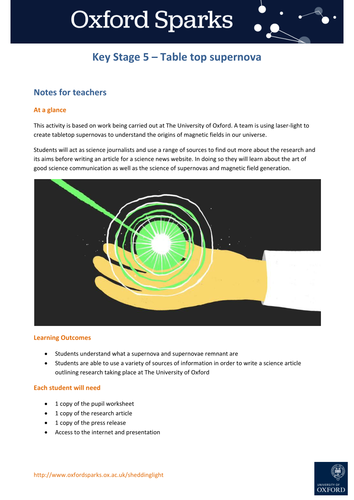









Light is more than just light bulbs and sunshine. Researchers can use different types of light to investigate and do a range of things. This activity is based on work being carried out at the University of Oxford. A team is using laser-light to create table-top supernovas to understand the origins of magnetic fields in our universe.
Students will act as science journalists and use a range of sources to find out more about the research and its aims before writing an article for a science news website. In doing so they will learn about the art of good science communication as well as the science of supernovas and magnetic field generation.
Learning outcomes: 1) Understand what a supernova and supernovae remnant are; 20 Use a variety of sources of information in order to write a science article outlining research taking place at the University of Oxford.
See more at: http://www.oxfordsparks.ox.ac.uk/content/shedding-light-situation
Students will act as science journalists and use a range of sources to find out more about the research and its aims before writing an article for a science news website. In doing so they will learn about the art of good science communication as well as the science of supernovas and magnetic field generation.
Learning outcomes: 1) Understand what a supernova and supernovae remnant are; 20 Use a variety of sources of information in order to write a science article outlining research taking place at the University of Oxford.
See more at: http://www.oxfordsparks.ox.ac.uk/content/shedding-light-situation
Something went wrong, please try again later.
This resource hasn't been reviewed yet
To ensure quality for our reviews, only customers who have downloaded this resource can review it
Report this resourceto let us know if it violates our terms and conditions.
Our customer service team will review your report and will be in touch.
£0.00
